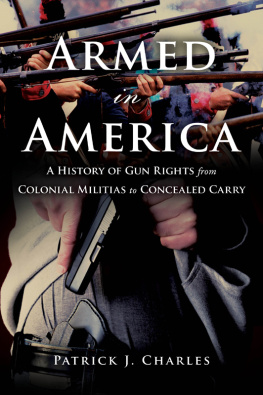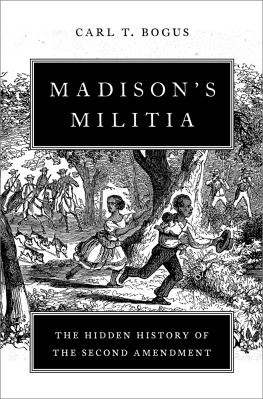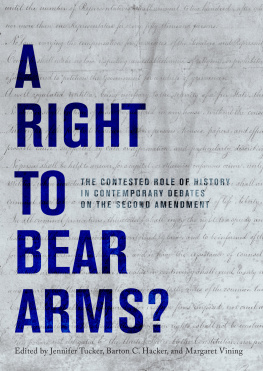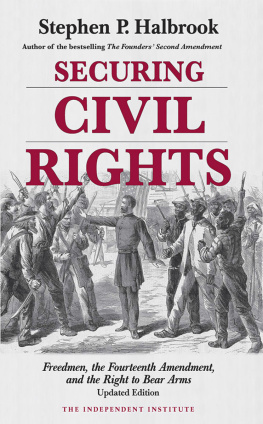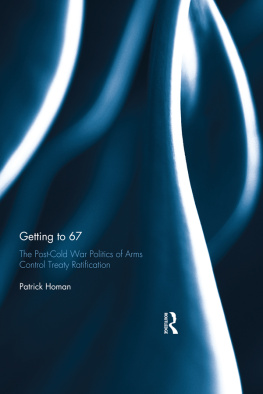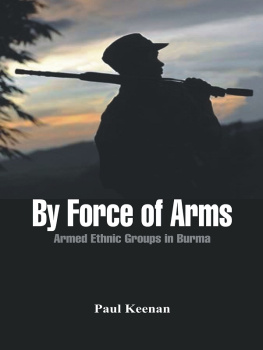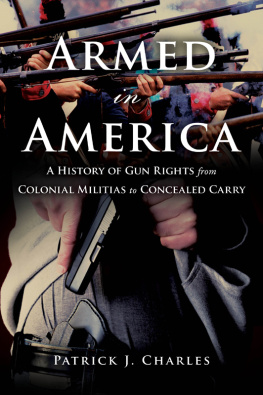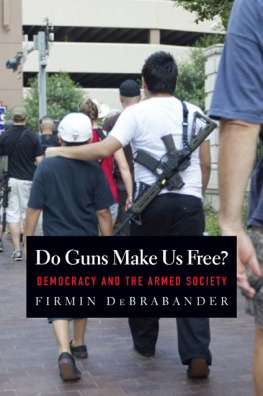
I am indebted to a number of historians and legal professionals for their friendship, mentorship, guidance, and support over the years. This includes Adele Alexander, David Armitage, Muriel Atkin, Richard L. Aynes, Stephen Banks, Josh Blackman, Joseph Blocher, Nemata Blyden, James S. Cockburn (deceased), Saul Cornell, Thomas Y. Davies, Nora V. Demleitner, Garrett Epps, Paul Finkelman, David F. Forte, Mark Frassetto, Ranjit Hakim, Tim Harris, Peter Hoffer, Woody Holton, James Horton, Calvin H. Johnson, Stanley N. Katz, Erin Rahne Kidwell, David Thomas Konig, Nathan Kozuskanich, Edward G. Lengel, Suzanne Loose, Robert E. Mensel, Darrell A. H. Miller, Kevin F. O'Neill, William O'Reilly, Willian Pencak (deceased), J. G. A. Pocock, Jack N. Rakove, Francine Radford, Michael Rappaport, Reggie Robinson, Rachel E. Rosenbloom, David Rubenstein, Mike Sacks, Priya Satia, Michael A. Scaperlanda, Peter H. Schuck, Lois G. Schwoerer, Quentin Skinner, Lawrence Solum, Steven H. Steinglass, Juliet Stumpf, Mary Thompson, Jennifer Tucker, Tess Webber, Judy Weiss, Geoffrey Wyatt, and I am sure others who escape me at this moment.
Much of the material in this book could not have been accessed if not for the assistance of others, including Kelvin Chan, Jordan Gusich, and a number of institutions, such as Duke University, Florida State University, George Washington University, Indiana University, Louisiana State University, Michigan State University, Ohio State University, University of Houston, University of Kansas, University of Maryland, University of Pittsburgh, University of Virginia, New York Public Library, British National Archives, Herbert Block Foundation, Billy Ireland Cartoon Library and Museum, John F. Kennedy Presidential Library and Museum, Franklin D. Roosevelt Presidential Library and Museum, Lyndon B. Johnson Presidential Library, Society of the Cincinnati, Kansas Historical Society, Wisconsin Historical Society, and the Library of Congress.
A special thanks to my agent, Alexa Stark, for taking on this project. And last but not least, I want to acknowledge my close friends, colleagues and coworkers within the special operations community, and family for their continued help and support, and my canine writing companionsAJ, TJ, and Bennyfor listening to me write out loud for more than a decade. And, of course, a special thanks is due to my spouse, Nadejda Demiscan Charles, for putting up with me during the long process of writing this book, all the while being pregnant with our daughter and dealing with the added stress of building our first home.
In 1993, Pulitzer Prizewinning editorial cartoonist Herbert L. Block published Daily Sacrifices, depicting the victims of gun violence being carried to the base of a handgun monument. Inscribed on the base is In Guns We Trust. Considering Block's larger body of editorial work, it is clear that Block is advocating on behalf of stricter firearm controls. At the same time, perhaps unbeknownst to Block when he drew it, by incorporating the motto In Guns We Trust the cartoon captured the heart of the longstanding debate over the Second Amendmentthat is, what does the right to keep and bear arms afford the American people, and what is the proper role that firearms should play in American society. It is a debate that transcends ideological, ethical, political, legal, and cultural lines. It also a debate about what constitutes American values. It is a debate more commonly known as gun rights versus gun control.
Before delving into this debate, it is worth mentioning how American views on the ownership, availability, and use of firearms vary greatly. Views can vary dependent upon race, sexual orientation, whether the individual owns firearms, and so forth. They just disagree on whether the problem should be solved by loosening or strengthening firearm controls.

Herb Block, The Daily Sacrifices, 1993. This image was reprinted with permission from the Herb Block Foundation.
To most foreigners, it is astonishing that Americans portray the subject of gun violence in terms of gun rights versus gun control. From their perspective, gun violence can be easily solved by instituting strict firearm controls.
Foreign amusement over the amount of violence in the United States is not a twenty-first century phenomenon. It has been ongoing for nearly two centuries. During the Antebellum Era, when French aristocrat Alexis de Tocqueville set out on an extensive tour of the United States, he observed that there was a greater propensity for violence among Americans living in the South than those living in the Historic Northeast.
As the United States progressed into twentieth century, Tocqueville's and Dickens's observations were still relevant. The homicide and crime rates of the South were more than twice as high as the Historic Northeast, and the homicide and crime rates of the United States were more than ten times that of other developed countries.
While many Americans are quick to dismiss foreign criticisms as just thatforeignthey often do so in haste. Granted, foreigners are generally socialized under a different system of government, but it is worth considering the statistics. The United States maintains less than five percent of the world's
Another observation worth considering is federal inaction in preventing or curtailing the problem. Despite gun violence being one of the top two non-disease-related causes of death in the United States, Congress has failed to pass any comprehensive firearms legislation or controls since the 1994 Federal Assault Weapons Ban (AWB), which expired in 2004. As the late Massachusetts Democratic senator Edward M. Kennedy once put it, the United States is internationally known for being first in guns, last in controls.
There is even an argument to be made that Congress has intentionally turned a blind eye to curtailing gun violence. In 1996 for instance, Congress not only cut the Center for Disease Control's (CDC) budget to study gun violence but also barred the CDC from using federal funding to take a position on gun control.
In recent years, a growing number of congressmen have endorsed two federal firearms bills that would materially alter longstanding gun-control norms. The first federal firearms bill would encroach upon the state governments more than two century monopoly on concealed-carry regulations. Rather than each state government controlling who may carry concealed firearms, the proposed federal firearms bill would allow concealed-carry license holders in one state to carry a concealed firearm in any other state, regardless of how lax the qualification requirements in the state issuing the license might be.
This is not to say that there has been complete congressional inaction in trying to prevent or curtail gun violence. Due largely to the rise of mass shootings since 2002, some members of Congress have called for a debate on gun control, and have even tried advancing a myriad of gun-control measures. However, in every instance such efforts were defeated at the behest of gun-rights advocates.
The recent mass shooting in Las Vegas, Nevadathe deadliest mass shooting in modern American historymay prove to be a turning point. On the night of October 1, 2017, Stephen Paddock, armed with nearly two dozen firearms, shot from the thirty-second floor of the Mandalay Bay Resort and Casino into a Route 91 Harvest Festival crowd of nearly 22,000 people, killing more than fifty people and wounding another five hundred.

